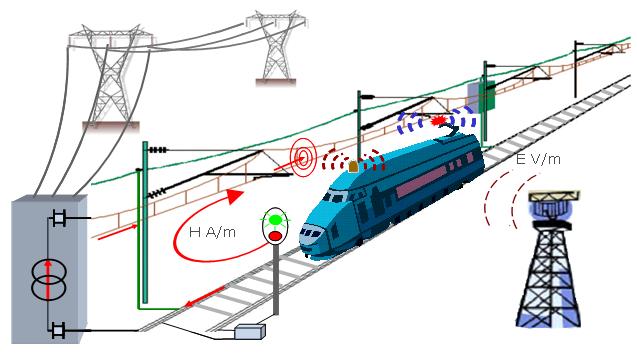EMC of Railways - Pantograph Arcing

Project members:
Prof. Rajeev Thottappillil (Main supervisor)
Adj. Prof. Mats Bäckström (Combitech AB)
• Dr. Thorsten Schütte, (past member, now at ATKINS Global)
• Surajit Midya (past member, now at Bombardier, Stockholm)
Sponsor: Banverket, Bombardier Transportation [1998-2010]
Brief Description:
The arcing between the pantograph and the contact wire is a common phenomenon and. It is more predominant at high speed, increasing load, and in cold icy weather conditions such as those that can be found in Scandinavia. The attachment and detachment of the contact wire is similar to switching on and off an inductive load. Arcing at the pantograph distorts the regular waveform of the supply voltage and current and generates transients which propagate along the railway system, including tracks, track circuits, other locomotives on the same track, substation supply transformer, vehicle transformer, etc.. This causes interference voltages and currents in the frequency range from DC to several MHz and radio frequency emissions up to GHz. Net DC currents can cause interference to track circuits operating on DC supply voltage.
Railways in Europe, including Banverket, are moving towards the adoption of European Rail Transport Management System (ERTMS). Banverket is already implementing ERTMS for the Botniabanan and most high-speed lines will be upgraded to ERTMS by 2020. Eurobalises will be used for giving information on train position in both ERTMS level 2 and Level 3 and the driver gets information on tracks ahead and instructions on how to proceed through radio. The track circuits, eurobalises and most of the way-side equipments will be present in ERTMS 1 and 2, and therefore EMI issues to the wired signalling and control network will continue to be an important issue. Possible interference to the radio communication between the infrastructure (communication mast) and the driver in the moving train due to pantograph arcing and other sources are being investigated.
Keywords:
Railway EMC, pantograph arcing, ERTMS (European Rail Traffic Management System).
Related Publications
Daniel Månsson, Pierre-Vincent Verschraegen, "Modeling and Description of Pantograph Arcing", Electronic Environment 2011, April 2011
Surajit Midya, Conducted and Radiated Electromagnetic Interference in Modern Electrified Railways with Emphasis on Pantograph Arcing, Ph.D. thesis, Royal Institute of Technology (KTH), June 2009: TRITA-EE 2009:053
Surajit Midya, Dierk Bormann, Thorsten Schütte and Rajeev Thottappillil, "Pantograph Arcing in Electrified Railways—Mechanism and Influence of Various Parameters—Part I: With DC Traction Power Supply", IEEE TRANSACTIONS ON POWER DELIVERY, VOL. 24, NO. 4, OCTOBER 2009, pp: 1931-1939, DOI:10.1109/TPWRD.2009.2021035
Surajit Midya, Dierk Bormann, Thorsten Schütte and Rajeev Thottappillil, "Pantograph Arcing in Electrified Railways—Mechanism and Influence of Various Parameters—Part II: With AC Traction Power Supply", IEEE TRANSACTIONS ON POWER DELIVERY, VOL. 24, NO. 4, OCTOBER 2009, pp: 1940-1950, DOI:10.1109/TPWRD.2009.2021036
Surajit Midya and Rajeev Thottappillil, An Overview of Electromagnetic Compatibility Challenges in European Rail Traffic Management System, Journal of Transportation Research Part C: Emerging Technologies, Elsevier, Vol 16C, Issue 5, 2008, pp 515-534.
S. Midya, D. Bormann, A. Larsson1,3, T. Schütte and R. Thottappillil, “Pantograph Arcing and their Consequences to Electromagnetic Interference in Railway Systems”, EUROEM 2008, European Electromagnetics 21-25 July 2008 Swiss Federal Institute of Technology (EPFL), Lausanne, Switzerland.
S. Midya, T. Schütte and R. Thottappillil, “Interaction and Interference Between AC and DC in Railway Feeding Systems”, EUROEM 2008, European Electromagnetics 21-25 July 2008 Swiss Federal Institute of Technology (EPFL), Lausanne, Switzerland.
S. Midya, D. Bormann, A. Larsson, T. Schütte, and R. Thottappillil, “Understanding pantograph arcing in electrified railways – influence of various parameters,” in Proceedings of IEEE International Symposium on Electromagnetic Compatibility, Detroit, Michigan, USA, Aug. 2008
Midya, S, R. Thottappillil, T. Schütte, Consequences of DC Components In AC Railways and Their Elimination, Railway Engineering 2007, June 20-21, London, UK.
Dierk Bormann, Surajit Midya, Rajeev Thottappillil , "DC Components in Pantograph Arcing: Mechanisms and Influence of Various Parameters", EMC Zurich 2007, Munich, Germany, 24th to 28th Sept, 2007
